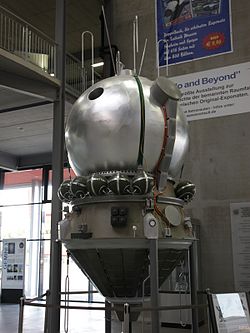STS-65
| STS-65 | |||||
 | |||||
| Uppdrag | 63 | ||||
|---|---|---|---|---|---|
| Rymdfärja | Columbia (17)[1] | ||||
| NSSDC-ID | 1994-039A[2] | ||||
| Färdens tid | 14 dagar, 17 timmar, 55 minuter | ||||
| Uppskjutning | |||||
| Startplats | Startplatta 39A vid Kennedy Space Center i Florida | ||||
| Start | 8 juli 1994, 12:43:01 p.m. EDT | ||||
| Landning | |||||
| Landningsplats | KSC Runway 33 | ||||
| Landning | 23 juli 1994, 6:38:01 a.m. EDT | ||||
| Omloppsbana | |||||
| Varv | 235 st[3] | ||||
| Apogeum | 304 km | ||||
| Perigeum | 300 km | ||||
| Banlutning | 28,45° | ||||
| Sträcka | 9,886 miljoner km | ||||
| Besättning | |||||
| Befälhavare | Robert D. Cabana (3) | ||||
| Pilot | James D. Halsell (1) | ||||
| Uppdragsspecialister | Carl E. Walz (2) Leroy Chiao (1) Donald A. Thomas (1) | ||||
| Nyttolastspecialister | Richard J. Hieb (3) Chiaki Naito-Mukai (1) Japan | ||||
 | |||||
| Kronologi Rymdfärjeprogrammet | |||||
| |||||
STS-65 var en flygning i det amerikanska rymdfärjeprogrammet med rymdfärjan Columbia. Den sköts upp från Pad 39A vid Kennedy Space Center i Florida den 8 juli 1994. Efter nästan femton dagar i omloppsbana runt jorden återinträdde rymdfärjan i jordens atmosfär och landade vid Kennedy Space Center.
Besättning
- Robert D. Cabana
- James D. Halsell
- Richard J. Hieb
- Carl E. Walz (2)
- Leroy Chiao
- Donald A. Thomas
- Chiaki Naito-Mukai
- Jean-Jacques Favier (Backupbesättning)
Se även
Referenser
- ^ NASA Space Shuttle Launch Archive Arkiverad 4 februari 2012 hämtat från the Wayback Machine., läst 28 juli 2016.
- ^ ”NASA Space Science Data Coordinated Archive” (på engelska). NASA. https://nssdc.gsfc.nasa.gov/nmc/spacecraft/display.action?id=1994-039A. Läst 20 mars 2020.
- ^ Manned Astronautics - Figures & Facts Arkiverad 4 mars 2016 hämtat från the Wayback Machine., läst 28 juli 2016.
Externa länkar
 Wikimedia Commons har media som rör STS-65.
Wikimedia Commons har media som rör STS-65.
| ||||||||
| ||||||||||||||||||||||||||||||||
Media som används på denna webbplats
STS-59 crew insignia
- The STS-59 insignia is dominated by Earth, reflecting the focus of the first Space Radar Laboratory (SRL-1) mission upon our planet's surface and atmosphere. The golden symbol of the astronaut corps emblem sweeps over Earth's surface from the Space Shuttle Endeavour, representing the operation of the SIR-C/Synthetic Aperture Radar (X-SAR) and the Measurement of Air Pollution from Space (MAPS) sensors. The astronaut emblem also signals the importance of the human element in space exploration and in the study of our planet. The star field visible below Earth represents the many talents and skill of the international SRL-1 team.
Författare/Upphovsman: Pascal (Flickr user: pasukaru76), Licens: CC0
Vostok spacecraft replica at the Technik Museum Speyer, Germany.
The crew assigned to the STS-65 mission included (seated left to right) Richard J. (Rick) Hieb, payload commander; Robert D. (Bob) Cabana, commander; and Donald A. Thomas, mission specialist. Standing, from left to right, are Leroy Chiao, mission specialist; James D. Halsell, pilot; Chiaki Naito-Mukai, payload specialist; and Carl E. Walz, mission specialist. Launched aboard the Space Shuttle Columbia on July 8, 1994 at 12:43:00 pm (EDT), the STS-64 mission marked the second flight of the International Microgravity Laboratory (IML-2) and the first flight of a female Japanese crew member.
STS-65 Mission Insignia
STS-64 Mission Insignia






